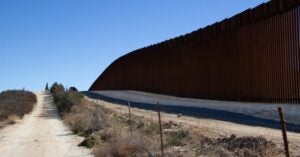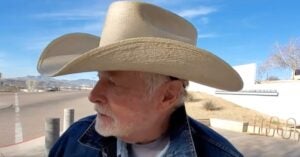The discussion about the United States-Mexico border has spanned several presidents and has spawned aggressive debate about measures such as security, detention, and asylum. It’s unavoidably political. Border and immigration policies are repeatedly introduced in committees only to flounder, ultimately falling victim to partisan attempts at leveraging the crisis and capitalizing on economic impacts.
Whereas politicians’ fate may rest on their support or opposition to the border effort, ranchers operating in New Mexico, Arizona, and Texas, take pride in their resilience — sometimes for generations — and find ways to adapt to a landscape that moves more quickly on the Southwestern ground than it does in the U.S. Capitol.
History unfolds along the border
In the early 20th century, the border witnessed relatively lax immigration controls. The first Bracero program allowed U.S. farms and ranches to employ Mexicans to work beginning in May 1917, after the U.S. entered World War I. However, in the 1920s, nativist sentiments rose, culminating in immigration restrictions such as the Immigration Act of 1924, limiting the number of immigrants allowed entry into the U.S. through national origins quotas. Then, “repatriation” campaigns during the Great Depression in the 1930s led to the deportation of hundreds of thousands of Mexican Americans and immigrants.
When the U.S. found itself short of able-bodied men in July 1942, during World War II, a second Bracero program was established as part of an agreement between the U.S. and Mexican governments. The program allowed Mexican immigrants seeking agricultural work to take temporary farm, ranch, and railroad jobs in the states during a time when America sought radical solutions for their labor needs after manpower shortages created by the war. Ciudad Juarez and Chihuahua, across from El Paso, Texas, became historic recruitment sites where thousands of unemployed Mexicans came to secure work in the Southwestern U.S.
Today, the Bracero program is hailed as having converted the agricultural fields of America into the most productive land on the planet.
Throughout the program, enacted into public law in 1951, over 4.5 million Mexican citizens were legally hired to work in the United States, primarily in Texas and California. However, as the number of Mexican workers searching for fair work across the border rose, the number of illegals who entered the U.S. began to surpass the number of Braceros.
In 1955, 1.3 million people were swept up in the Eisenhower-era campaign dubbed Operation Wetback, the largest mass deportation of undocumented workers in U.S. history. The operation used military-style tactics to remove Mexican immigrants (some of them were even American citizens) from the U.S., sending them to Mexico.
As the late 20th century (1970s-1990s) unfolded, legal battles focused on migrant and labor rights, with landmark rulings like Plyler v. Doe affirming education rights regardless of immigration status. The Immigration Reform and Control Act of 1986 provided amnesty but also imposed sanctions on employers hiring undocumented workers, requiring employers to attest to their employees’ immigration status. It became illegal to knowingly hire or recruit unauthorized immigrants.
It was estimated that around 300,000 undocumented workers were employed annually, mostly on a seasonal basis, on farms and ranches. The H-2A agricultural program expanded an existing H-2 agricultural worker program where employees could hire undocumented aliens to complete seasonal or temporary agricultural work when insufficient legal workers were available. The revamped program allowed up to 350,000 legal, special agricultural workers to perform seasonal agricultural work in perishable commodities.
The programs had difficulty succeeding, and crops were rotting while regulations held up specialty workers. In June 1987, the Immigration and Naturalization Service relaxed procedures to allow migrant workers to enter the U.S. to pick perishable crops. Still, the cost and regulations surrounding the program left farmers with labor challenges.
Into the 21st century, border enforcement escalated. The federal government erected physical barriers, and the U.S. Border Patrol, a law enforcement agency under the U.S. Customs and Border Protection, expanded. Legal battles intensified, particularly over programs like Deferred Action for Childhood Arrivals and Deferred Action for Parental Accountability, offering temporary relief to undocumented individuals brought as children or parents of citizens.
Then, President Donald Trump’s “zero tolerance” policy and family separations at the border sparked widespread outrage and legal challenges, alongside ongoing litigation addressing asylum rights and detention conditions. Under the Trump administration’s policies, the Department of Justice began to criminally prosecute all suspected illegal border crossers.
In 2017, Trump issued Executive Order 13767, titled Border Security and Immigration Enforcement Improvements, directing a wall to be built along the U.S.-Mexico border. By 2020, nearly 400 miles of the new border wall system was completed.

Over the past three years, the Biden administration has taken over 535 immigration actions. Humanitarian efforts on refugee admissions have moved enforcement priorities to narrower categories of unauthorized immigrants. According to Office of Homeland Security statistics, the southern border has witnessed a record 6.3 million migrant encounters at and between ports of entry since 2021.
A key piece of the policy at that time was Title 42, an emergency health authority that allowed U.S. officials to turn away migrants who came to the U.S.-Mexico border on the grounds of preventing the spread of COVID-19. It lasted for three years, starting in March 2020.
Title 42 resulted in fewer removals by U.S. Immigration and Customs Enforcement, but after its end, the Department of Homeland Security’s removals and returns ballooned to over 470,000. As of 2023, 6.2 million cases of non-detained migrants on ICE’s docket — monitored by restricted-use cell phones and ankle monitors — were recorded. Under the Family Expedited Removal Management program, 822,000 individuals arrived as part of families during the fiscal year 2023. However, as of September 2023, only 1,600 families had been enrolled in the program.
Continued series of actions by the Biden administration to increase enforcement along the Southwest border have focused heavily on efforts surrounding asylum seekers and immigrants at ports of entry.
Recent policy fails to fill the void
It’s crucial to understand this intricate history, woven with legal struggles, political maneuverings, and human stories, all shaping the landscape of immigration and border policy for generations to come. It’s unlikely anyone understands the complex repercussions that decisions made by lawmakers in D.C. have had on the U.S.-Mexico border relations better than farmers and ranchers living there.
As the impacts of immigration policy spread inward toward cities and towns far from the border, farmers and ranchers along the Southwest border say they have felt particularly vulnerable. They report being burdened with not only the costs incurred by illegal trespassers but also those who seek to evade Border Patrol’s apprehension.
After the Biden administration terminated the construction contracts for the border wall in 2021, the chaos of high-speed vehicle chases became more prevalent. Ranchers had to cope with the aftermath of downed fences after smugglers, known as “Coyotes,” crashed through them. Too often, they’d leave swaths of damage as they fled law enforcement.

In a Committee on Homeland Security Majority Report completed in November 2023, the net cost of illegal immigration was found to be greater than the annual gross domestic product of 15 individual states. The report predicts that the cost of the border crisis could exceed $451 billion annually, not including costs incurred by farmers and ranchers along the border who are forced to fix and repair damage created by illegal immigration activities.
“Illegal immigration costs every American taxpayer a net average of $956 — or $1,156 before the taxes paid by illegal aliens are factored in,” the report said. “These costs also represent a substantial increase from previous studies. FAIR’s 2017 cost study found illegal immigration imposed topline costs of $135 billion, with around $19 billion paid in taxes by illegal aliens.”
While illegal immigration has long been an issue for border ranchers, the South Texans’ Property Rights Association, which represents 500 South Texas ranchers, says that things have gotten worse under the current administration. In fiscal year 2023, a record 2.5 million encounters — events categorized as apprehensions and expulsions — occurred at the U.S.-Mexico border.
One anonymous rancher the Texas Farm Bureau highlighted noted that the ranch spent nearly $120,000 on fencing repairs one year. That same rancher said he endured people driving through 16 fences in just one day.
“There are no rules; their job is to get people from point A to point B, and they’ll do whatever it takes to make that happen,” that rancher said.
Another anonymous rancher in Maverick County told the National Review that, in 2021, he lost 130,000 gallons of fresh water and saw “more property damage than if I were to add 30 years together.”
Another Maverick County rancher reported finding more bodies on their ranch than ever in 2021. Another rancher in the same county told the Epoch Times that trespassers had beaten his dogs with sticks and thrown rocks at him.
In a recent op-ed referencing President Joe Biden and Homeland Security Secretary Alejandro Mayorkas, the Washington Examiner put it bluntly, “In an industry like agriculture, in which the margin of profit is already small, the Biden and Mayorkas border crisis is only adding insult to injury. These unexpected costs can lead to ranchers losing their property.”
The heritage that can’t be left behind
It’s a situation that continues to jeopardize border ranches’ livelihoods and family structure. In 2022, U.S. Rep. Tony Gonzales from Texas introduced two bills — the RAPID Act and the SAFE Act — to help create new reimbursement programs for families along the border. While the RAPID Act aimed to repurpose funding from the American Rescue Plan to cover damage costs, the SAFE Act was supposed to create a grant program for border families to help enhance property security and get reimbursed for damage.
“Many of the women I’ve talked to seem to resonate with the need for safety. They’re concerned with their family’s well-being and their security,” explained New Mexico rancher Erica Valdez. “Some men, my husband, for example, are disheartened and frustrated with the constant property damage and destruction.”
In an emotional interview with Fox Business, Texas rancher John Paul said, “We shouldn’t be afraid in our own homes.”
Border ranchers, keen to always carry firearms, understand the magnitude of taking a life. Aside from the gravity of taking something that can’t be given back, the legality of shooting trespassers weighs heavily on landowners.
In one high-profile instance, Arizona rancher George Alan Kelly awaits a trial date on counts related to the fatal shooting of a migrant on his property. In 2023, Kelly, 75, was arrested and charged with second-degree murder and aggravated assault in the death of a 48-year-old Mexican national who Kelly said was in a group trespassing on his property.
While prosecutors accuse Kelly of recklessly firing his AK-47 toward the migrants, Kelly’s lawyer says that he feared for the safety of himself and his wife.

A bill moving through the Arizona House of Representatives hopes to make changes to state law, permitting Arizonans to use deadly force against people who are trespassing or breaking into their homes.
Rep. Justin Heap, a Mesa Republican, told the House Judiciary Committee on Feb. 14 that his House Bill 2843 is designed to close a loophole that he claims has led to “increasingly larger numbers of migrants or human traffickers moving across farm and ranch land.”
There’s no easy solution for ranchers on the border, and the constant pressures and stressors lead many to question why they would stay.
For families like the Valdezes in New Mexico, packing up and selling the ranch would mean selling family heritage. Property values along parts of the border, such as south of Interstate 10 stretching from Arizona to Texas, have dropped drastically, making reinvestment in ranches farther from the border unfeasible.
While livestock is considered a liquid asset, to sell out a herd means decades and sometimes centuries of lost genetics adapted to a specific region and to a rancher’s needs. Meanwhile, land takes longer to move than livestock, and borderlands present unique marketing challenges.
Ranches are often multi-generational, with pastures, facilities, and knowledge and respect for the land built by the hands of subsequent generations.
“Though it is difficult to ranch along the border, it’s a legacy. Agriculture isn’t just a job; it’s a way of life. And, with my family being here for over 100 years, it’s not something we just want to give up on,” said New Mexico rancher Russell Johnson.
And, it’s a point of pride, as Arizona rancher Jim Chilton so clearly conveyed when he said, “It’s our custom, our tradition, and our culture. We have a family cemetery on the ranch, so I’ll either be here on top of the ground or below ground.”
This article is the third in a three-part series delving into the unique hazards for ranchers who operate near the border with Mexico and how they respond to a changing landscape that includes illegal immigration, drug cartels, and human trafficking. The explorative series, titled The Dangerous Divide, is an AGDAILY exclusive.
Heidi Crnkovic, is the Associate Editor for AGDAILY. She is a New Mexico native with deep-seated roots in the Southwest and a passion for all things agriculture.



